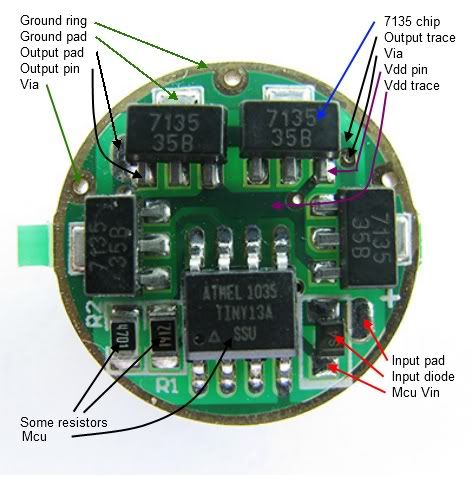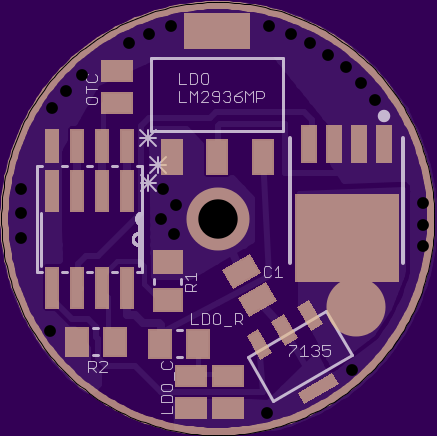An nanjg guide maybe?
^ That is a tough one due to layout. We really need to pick a SMD package for the LM2936 and get some OSH Park boards available.
But this thread is about modding existing drivers, so lets see. The hard part will be the series Resistor and Output Cap that will be needed between the Output Pin 3 and Ground. Without wires, the only place I see for them is between the MCU VCC Pin (Pin 8 ) and the Ground Pin (Center Pin) of the 7135 across from it. Probably couldn't get a programming clip on the MCU afterwords. These steps probably won't be understandable without a picture of it done, but here goes (See pics below for reference):
- Pull the stock diode
- Test fit LM2936 and cut legs to desired lengths
- Solder Pin 1 to old diode input pad
- Solder Pin 3 (Out+) to old diode output pad
- Lay out a resistor (around 4 ohms) and a 10uF cap in line with each other between the MCU VCC Pin (Pin 8 ) and the Ground Pin (Center Pin) of the 7135 across from it. The resistor should be touching the MCU Pin 8 pad and the Capacitor should be touching the 7135 Ground pad. Make sure they don't touch any other nearby pads. Solder in place.
- Solder Pin 2 (GND) to large (or center) tab of nearest AMC7135 chip or any other ground location.
This will only work in a 2S or more cell arrangement.
Bottom Pin 1 (Batt+), Center Pin 2 (GND), Top Pin 3 (Out+)
Link to below picture in picture.
EDIT: Tried to fix smiley created by having an "8" next to a paren.
This one is Wight's 22mm DD+7135. Gonna use it in a 2S3P cell arrangement for light for my wife. Here are the 3 parts needed to convert it over. I decided to connect the LM2936 Batt+ and Batt- input pins to both sides of the C1 capacitor that goes on the pads to the right of the below LM2936 (Mouse over for blank board). The output capacitor needs to be 10uf minimum and needs a resistor to get proper ESR.
Here it is installed. I decided to use 2 10uf capacitors for the output pin. The light will be a momentary switch light and the OTC pads will be used to connect the switch.
It works great so far in bench testing.
Update: Bee using the above driver in this light. Working great. I eventually want to to change the 4.7ohm resistor with a .75ohm resister as recommended by the data sheet for the LM2936.
Got some new LM2936's. They are also the 5 volt version, but are in a SOT-223 package. LM2936MP pictured on the right.
I haven't used these yet. I intend to design some boards that will use them. They are much bigger than 7135's. Pilotdog68 rendered this drawing to show me how much bigger the SOT-223 is than the AMC7135 SOT-89. Probably will be limited to bigger boards.

A bit off-topic, but what host are you using for the 2s3p build?
^ It will be one of those 12 emitter lights that are like the Retard Light RaceR86 made.
I actually plan on swapping in one of your OSH Park boards eventually. I would like to have enough 7135's to run all modes but turbo. Maybe High and Turbo.
I’ve quickly put together a board that might help with testing these.

Sorry, gotta ask. Edited: I’m not too lazy/ignorant to read though the whole thread, I just did, but it didn’t provide me with an answer…
The idea is to provide the MCU with a lower voltage on a multiple cell configuration? If so, why not just use two resistors and make a voltage divider?
pyro1son,
Damn, that board looks great! Love all the vias, positive lead through hole, MCU footprints and layout. Ordered a set. I'll test it and report back as soon as it arrives. Thank you very much. :)
Mike C,
Thanks for asking. The idea is to have as low of parasitic drain as possible to help prevent ruining cells. You have my attention. What size resistors would you use that would provide adequate current and voltage to power an MCU (in high mode) and a buck converter in a 4S setup? How much parasitic drain would it have?
I haven’t done any calculations on this myself so I don’t have any size recommendations. I guess it depends on how much current the MCU will use at the most. Parasitic drain will probably be higher than with the LM2936 but better than a zener. Should be able to get it down to about 1mA with the right resistors and firmware… but to be honest I’m just guessing really, I haven’t haven’t had to worry about this much as my double voltage drivers all have power switches so parasitic drain is not really a concern for me, I was just thinking out loud…
A side comment on something I picked up earlier in this thread… I’m using 1300K and 300K resistors for the voltage divider on my latest driver design which has OTC, momentary switch and voltage input on the same pin. I’m not having issues with the high impedance. I always do two ADC conversions, discarding the first and using the result from the second. So far the results have been very reliable.
Awesome news on your side comment. That's some cutting edge stuff you are working on there. Been wanting to catch up on it. I think you have some info on it in the Attiny 25 thread and maybe some other places. Do you have a dedicated thread where you are working on that? It sure sounds exciting given the space and pin limitations of our drivers.
No dedicated thread yet. I was going to make one with the latest driver but got a problem with voltage always on the FET pin so I’ve pushed through a new design with OSH Park that I should be getting within two weeks or so. I don’t know what caused the problem so I don’t know if I’ve fixed it, but should be ok with the new one as I’ve increased isolation for all signal paths and moved some stuff around a little.
In the meantime I’ve ported my ATtiny84 dual switch firmware to the 85 with this three for one pin design, and am using the above mentioned board (with FET removed) to test it all. I’m just about to put it in a light for testing (which I’ll probably end up giving away soon as I’m reaching 1000 posts fast…)
^
You a machine Mike C. Best of luck testing the board. If you need some help testing, let me know. I can order the boards and do what I can.
EDIT: nix that. I just realized I don't have any Attiny85's.
pyro1son,
Been checking our your board. Real nice work you've done there. You have a PM inbound.
Thank you pyro1son. I ordered a set and will report back as soon as possible. Really excited about these. :)
You’re very welcome
Interesting in following the progress of this. Didn't know bout this thread til now. Nice work guys!
I have to say that I am very happy with the LM2936. My mods with it are doing great. I haven't been locking them out and they holding cell voltages great. I just wish this regulator came in a smaller package. The micro regulators I have looked at have much lower voltage input range. Since I have a lot of 4S lights, I like the cushion the 40V capacity gives.
I have received your boards from OSH Park pyro1son. I've been trying to figure out what light to put the first one it. I have decided on the Fenix TK75 with 4S2P cells, driving an XHP50 and 2 XM-L2's (all in series). I will be reflowing right after I log off.
I'm looking forward how you go with your led set up. With the light I built using a similar reflector (Shocker) with two XML and a single MTG-2 l ended up removing the MTG-2 and running three XML-2. The difference was not as great as I thought it would be. The XHP70 with its extra output may be the way to go.
^
Thanks for that info. I'm getting close to finishing that light. I'll report back on it.
pyro1son,
Your board works well. I'm not using a AMC7135 in this build, but it looks like it should would fine. I have taken a couple pics that I will posts soon. Thank you again for creating it. I have a little feed back, but nothing serious:
- I'm a little concerned with how thin the exposed top ground "ring" is. Doesn't appear that it will make good contact. I don't need it in my current build. I will augment it on future builds if needed.
- The AMC7135 pads are a bit close to the edge of the board.
- Not sure if this is an issue. I have noticed some of the traces are quite thin. The ones I noticed are low current traces. So they are not a problem. I need to check the traces that handle more current to make sure they are thick enough.

